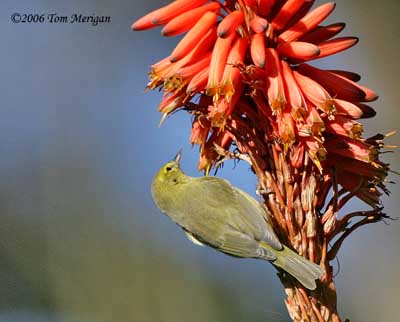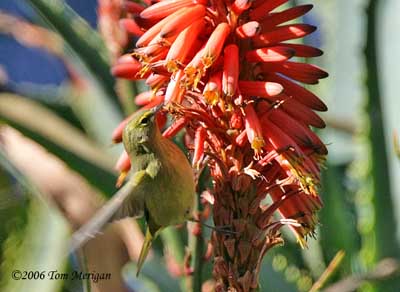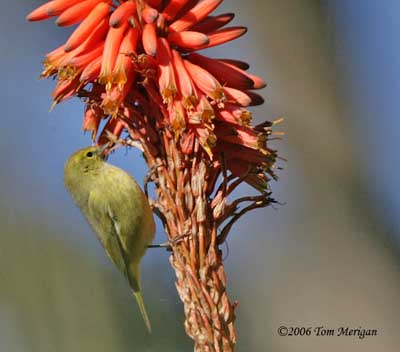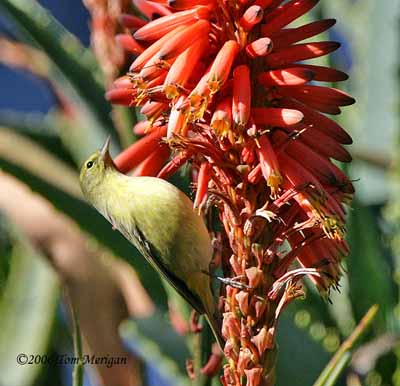
Orange-crowned Warbler
Leiothlypis celata
Passeriforme Order – Parulidae Family
BIOMETRICS:
Length: 11-14 cm
Wingspan: 19 cm
Weight: 7-11 g
LONGEVITY: Up to 6 years
DESCRIPTION:
Orange-crowned Warbler is olive above and paler below. It has yellow undertail coverts and faint, blurred streaks on sides of breast. It has greenish yellow underside and bright yellow on rump. Is has grey crown and small dark eye line, and a thin, broken pale eye ring. Usually hidden, we can see a small orange patch in middle of the crown. Bill is thin and pointed, slightly down curved, and horn-coloured. Eyes are black. Legs and feet are pale brown.
Fr: Paruline verdâtre
All : Orangefleck-Waldsänger
Esp: Chipe Deslustrado
Ital: Beccavermi corona arancio
Nd: Groene Zanger
Sd: Orangekronad skogssångare
Photographs of the bird in the red flowers byTom merigan
His website: Tom Merigan’s Photo Galleries
Photograph by Tom Grey
His website: Tom Grey's Bird Pictures
Text by Nicole Bouglouan
Sources:
A GUIDE TO THE BIRDS OF MEXICO AND NORTHERN CENTRAL AMERICA by Steve N. G. Howell, Sophie Webb - Oxford University Press - ISBN: 0198540124
BIRDS OF THE GREAT BASIN – by Fred A. Ryser - Univ of Nevada Pr -ISBN: 0874170796
FIELD GUIDE TO THE BIRDS OF NORTH AMERICA - National Geographic Society - ISBN: 0792274512
THE HANDBOOK OF BIRD IDENTIFICATION FOR EUROPE AND THE WESTERN PALEARCTIC by Mark Beaman, Steve Madge - C.Helm - ISBN: 0713639601
All About Birds (Cornell Lab of Ornithology)
Bird Web (Seattle Audubon Society)
Birds of Nova Scotia (Robie Tufts)
SORA Searchable Ornithological Research Archive (Blair O. Wolf)
What Bird-The ultimate Bird Guide (Mitchell Waite)
Wikipedia (Wikipedia, The Free Encyclopedia)

Plumage and size are variable according to the different subspecies, from smaller, brighter and yellower birds of western of United States, “lutescens”, to the dull “orestera” of the Great Basin and Rocky Mountains, to the dullest “celata” which breeds across Alaska and Canada, and the last “sordida”, the darkest green, found only in the Channel Islands and locally along the coast of S California and N Baja California.
Sexes are similar, with female duller and lasting crown patch.
Immature is duller than adults, with sometimes thin buffy wing bars.
VOICE: SOUNDS BY XENO-CANTO
Orange-crowned Warbler’s call is a sharp “chip”. Song is a thin, weak trill, dropping in pitch and volume at the end.
HABITAT:
Orange-crowned Warbler inhabits open, brushy woodlands, forest edges and thickets. It breeds in woodland groves, with moderately dense foliage.
It winters in thickets and shrubs along streams, forest and weedy fields.
During migration, they are often found at higher elevations, in alder or ash stands, or along lowlands streams.

RANGE:
Orange-crowned Warbler breeds from W Alaska across Canada to Labrador, southward in W United States to S California, Arizona and New Mexico.
It winters from California and coastal Virginia, southward to S Mexico and Guatemala.
BEHAVIOUR:
Orange-crowned Warbler generally feeds in low branches, often in dead leaf clumps, eating insects and berries. It flits into vegetation, to glean food at tip of twigs and leaves, also in tree blossoms. It moves rapidly from perch to perch, to probe into clusters of leaves or moss. It may hawk flying insects, and occasionally fly high up in trees.

Orange-crowned Warbler eats flower nectar, piercing the base of the flower to get at the nectar, and visit sapsucker holes for tree sap.
Orange-crowned Warbler is well-camouflaged by its grey-green plumage, and it usually forages silently and alone, but they can sometimes be found in mixed flocks, usually post-breeding or in migration. They often flick tail, staying low in bushes or small trees.
FLIGHT: Orange-crowned Warbler has an agile flight. It is a short to median-distance migrant.

REPRODUCTION:
Nest site is chosen by female which also builds the nest.
Orange-crowned Warbler’s nest is on the ground or in a low shrub, near the ground. It is an open cup made with leaves, fine twigs, bark, rootlets, weeds, moss, plant down and wool, and lined with fine grasses, moss and ferns.
Female lays 4 to 6 whitish eggs, finely speckled with reddish-brown.
Incubation lasts about 12 to 14 days, by female. Chicks are altricial and fledge at 8 to 10 days later, before they can fly well. Both parents care for young, almost entirely fed with insect larvae.
This species produces one single brood per year.

DIET:
Orange-crowned Warbler feeds on insects, spiders and berries. They eat mostly insects, but also suet, tree sap and flower nectar.
PROTECTION/ THREATS / STATUS:
Populations of Orange-crowned Warblers are abundant over much of range, but their numbers decrease to the East.
